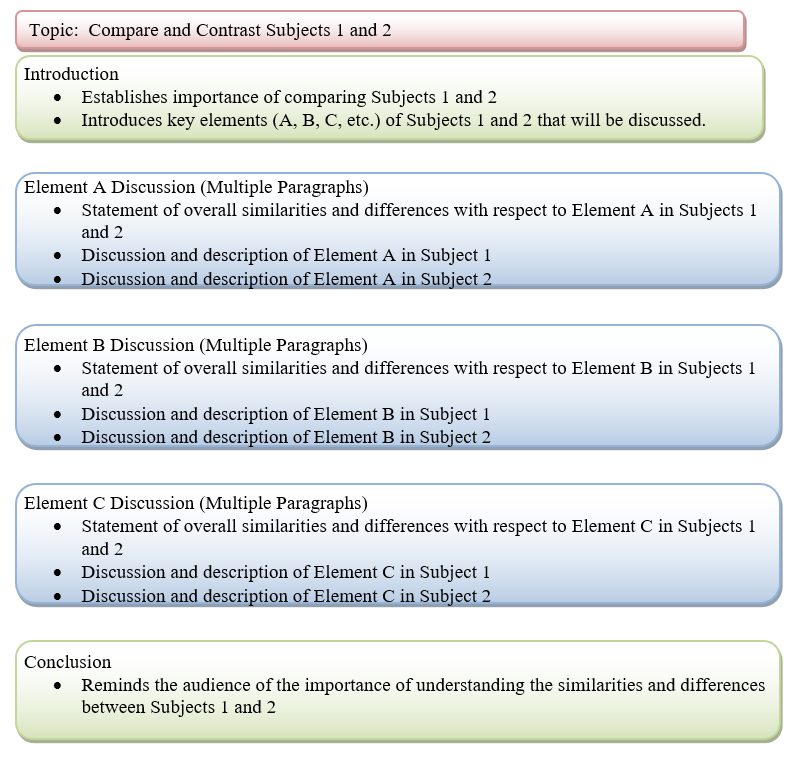Composition 03c: Organizing Compare-Contrast Essays
Organizing Compare-Contrast Essays
Most compare-contrast essays are structured according to one of two organizing schemes: either the block method of organization, where each subject is examined holistically in its own section of the paper, or the point-to-point method, where specific concepts or elements of the subjects are discussed alongside one another. The block method is easiest when the things under examination are relatively similar; the point-to-point method is often more effective when there are distinct differences in the subjects that are to be examined in some depth.
These two methods, just as the timeline did for the narrative, work with the planning tools that we discuss in this chapter, idea mapping and Outlining. A block or point-to-point organizational scheme for your essay should easily translate into an idea map or a well-developed outline, from which you can begin drafting your paper.
The Block Method
The block method of organization is called “block ” because it discusses each of its individual subjects—the things it sets out to compare—individually, in a “block” of text. This does not mean, however, that each section of the text simply lists all the features or traits of the subject; the writer that uses the block method should carefully select the most relevant or comparable elements of each to discuss in each respective “block” of the paper.
A discussion of two different competing pieces of health-care legislation, for example, would by necessity focus on specific elements of each bill. One might choose to discuss the possible benefits or expansions in healthcare coverage that each bill would provide, the financial costs of passing each respective bill, and finally, the possibility that each piece of legislation would actually be adopted. Each “block ” of text in the essay, then, would be devoted to discussing these three elements in each individual piece of legislation: benefits, costs, and probability of passage.
Likewise, if the paper’s task was to examine the operational structure of two (or more) professional sports teams, one might choose to focus on how each team approaches executive decision-making, player selection and development, and marketing. Each “block ” in this essay, then, would examine the operation of each of these elements in a specific team.
Most block compare-contrast essays use their discussion of their first subject as a baseline from which to discuss their second (and subsequent), using language in their second and subsequent “blocks” that recalls the first subject and signals comparison.
Often, in these essays, authors use language such as “In a striking contrast to [subject X], [subject Y] uses . . .” or “Bearing significant similarity to [subject X], [subject Y] features . . . .” to force their readers to remember that the purpose of the writing is to compare elements of each subject.
A typical “block ” compare-contrast paper might be organized in a manner similar to the following:
Introduction
- Background on Subject 1 and Subject 2
- Explain the benefit or necessity of comparing Subject 1 and Subject 2
- Thesis statement: While Subject 1 and Subject 2 are both _________________, they differ in ___________, ____________, and ____________ ways.
Block I: Discussion of Subject 1 (multiple paragraphs may be needed)
- Element 1 of Subject 1
- Description& Explanation
- Element 2 of Subject 1
- Description& Explanation
- Element 3 of Subject 1
- Description& Explanation
Block II: Discussion of Subject 2 (multiple paragraphs may be needed)
- Element 1 of Subject 2 (Refers to Element 1 of Subject 1)
- Description& Explanation
- Element 2 of Subject 2 (Refers to Element 2 of Subject 1)
- Description& Explanation
- Element 3 of Subject 2 (Refers to Element 3 of Subject 1)
- Description& Explanation
Analysis & Conclusion
- Summarizes overall similarities and differences between Subject 1 and Subject 2
- Offers assessment (if required by assignment) of merits or benefits of either subject over the other.
- Reminds audience of benefits of comparing Subject 1 and 2.
The Point-to-Point Method
This organizational scheme is a bit more sophisticated than the block method, and is far more effective for showing differences between two subjects. Whereas in the block method, each subject was discussed in its own section of the paper, with specific elements of comparison within each subject’s “block,” the point-to-point method addresses each specific element itself in its own section of the paper. This element-by-element structure allows the writer to make far more specific comparisons between the subjects being discussed, which is usually helpful in highlighting differences between them.
The basic point-to-point organizational scheme looks like this:

